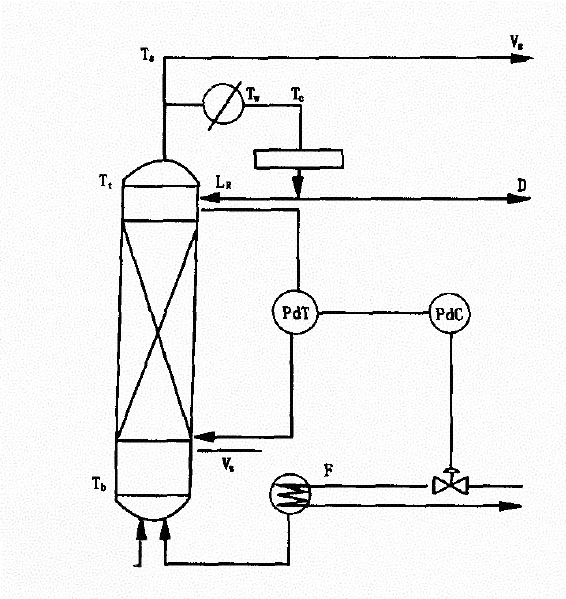Most spices are heat-sensitive organic compounds, and their content and aroma are important quality indicators. Vacuum fractionation is an important unit operation for spice separation. How to meet the special quality requirements of spices, which are mainly aroma, has always been one of the important research topics in the industry.
Vacuum Steam Fraction (VSF) combines the advantages of vacuum fractionation and vacuum steam distillation to better solve the problem of product aroma and purity. This technology has high application value and has been well applied.
Vacuum fractionator is improved on the traditional fractionation device.
Introduction
Vacuum steam fractionation can better meet the fractionation requirements of fine chemicals with complex components such as essential oils or spices. Compared with conventional vacuum fractionation, its heat-sensitive loss is significantly reduced, the product yield and aroma quality are improved, and it is easier to obtain products with less odor and pure aroma. It especially meets the special requirements of industries such as spices and pharmaceuticals for product purity and aroma. It is a new separation technology with great practical value and economic benefits.
1. Principle Analysis
Vacuum steam fractionation is based on the equipment and operation of traditional vacuum fractionation. A certain amount of saturated water vapor is added from the bottom of the fractionation pot for vacuum fractionation. The condensation effect at the top of the tower is controlled by selective condensation, so that the oil and water phases of the top distillate are separated according to different states and paths. That is, water vapor and a small amount of low-boiling point components (oiliness) are extracted from the top vacuum system, while the oil phase condensate participates in the top reflux, and different distillation section components are selected according to demand to obtain products with satisfactory content and aroma. The system configuration is shown in the schematic diagram.

(1) Under a certain vacuum, adding a small amount of saturated water vapor can reduce the vapor pressure of related components in the tower, thereby reducing the distillation operating temperature, which is conducive to reducing the "thermal sensitivity" loss of spices, and is conducive to the complete distillation of materials and improving product yield.
(2) According to the requirements of different spices or distillation sections, the system pressure (vacuum degree) and the amount of saturated water vapor added are controlled according to different parameters, which helps to evaporate the low-boiling point components better and faster and improve the separation efficiency. Stabilizing the vacuum degree and appropriately increasing the steam volume, or stabilizing the steam volume and increasing the vacuum degree, will reduce the temperature in the tower, speed up the evaporation rate and reduce thermal polymerization.
(3) Saturated water vapor enters the tower system from the bottom of the fractionation pot and rises with the tower plate. In addition to participating in mass transfer in the tower, it also releases a large amount of latent heat. This heat and mass transfer process strengthens the "absorption and washing" of the oil phase components by saturated water vapor, which is beneficial for water-soluble products (especially the charred products of heat-sensitive components) to rise and evaporate with the water vapor, thereby reducing the unpleasant "burnt smell" in the product and making the aroma better.
Application and Effect
As mentioned above, the use of VSF can not only reduce the temperature in the tower and reduce heat-sensitive losses, but more importantly, improve the product purity and aroma quality. This has great practical significance in the fragrance, pharmaceutical and other industries. This technology can be flexibly combined with different working conditions according to different needs. Achieve different effects:
1. Essential oil fractionation: Essential oils contain complex components with low boiling points, and the main components are isomers of aldehydes and alcohols and a variety of low-boiling terpene mixtures, such as citronella oil and litsea cubeba oil. To obtain alcohol or aldehyde compounds with a specified content and aroma through fractionation, this method is ideal. According to different materials and needs, the corresponding pressure (vacuum degree) P, pressure difference △P, reflux ratio R and Ts and Tw of the top condenser are controlled in different distillation sections. For example, this method can be used to fractionate citral with a content of 97% (GC) from litsea cubeba oil, and its yield and aroma are significantly better than traditional fractionation and chemical methods.
2. Remove a small amount of solvent: Some materials contain some solvents after reaction or treatment in the previous process. It is difficult to completely remove the solvent by conventional vacuum fractionation. It is necessary to control the reflux ratio for fractionation, resulting in too long heating time or too much distillate in the transition section. At the same time, the product contains a large solvent smell or burnt smell, which affects the aroma quality, which is very uneconomical. This method can be used to first use water vapor as the extraction agent, control the reflux ratio R and the condensation temperature, extract the solvent and steam, and then perform fractionation (water vapor can also be added if necessary). In this way, the product yield is high, and the aroma is pure and odorless. Products such as hydroxycitronellal, various series of esters, alcohols, etc. can all use this method with good results.
3. Essential oil finishing: Some essential oils are difficult to meet the market or next process requirements (such as low-concentration citronella oil, mountain litsea seed oil, etc.) because they contain more fore fractions. This method can reduce unnecessary material processing losses, shorten working hours, and the product is easier to meet physical and chemical indicators and economic requirements. For example, low-content citronella oil and mountain litsea seed oil are treated by this method, the content is increased, the color is not significantly deepened, and the loss is less (about 2-4%). It can meet export requirements.
Many years of application at home and abroad have shown that the use of VSF can not only effectively separate materials such as essential oils to obtain products with higher content, but also perform special treatment on various materials. More importantly, it can effectively remove odors or burnt odors brought by raw materials or produced in the process of product processing, making the aroma of the product purer.
Oleoresins Introduction
Stainless Steel Mixing Equipment Application
Plate Centrifuges Application
Contact: Project Manager
Phone: +86-18120438367
Tel: +86-18120438367
Email: info@tycoretech.com
Add: No. 1, Optics Valley Avenue, East Lake New Technology Development Zone, Wuhan, Hubei, China
We chat
